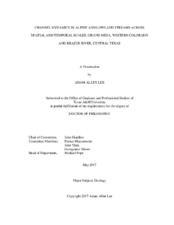| dc.description.abstract | Rivers and streams develop landform morphology in equilibrium with the flow of water and sediment through the channel. This dissertation examines features in fluvial systems with different geomorphic regimes; step-pool streams in Grand Mesa, western Colorado, USA and the meandering Brazos River, east-central Texas, USA.
Grand Mesa streams are unique with headwaters located on one of the largest mesas in the world. Large reservoirs with regulated discharges drain into each stream. Significant differences were found for standard step-pool characteristics of step height, channel width and step wavelength between the streams of Grand Mesa and step-pool streams in mountain-peak alpine areas. The stage of channel evolution for step-pool streams shows the Grand Mesa channels as either approaching or having obtained an idealized channel form from distribution of energy within the system.
Rates of lateral channel migration occurring along a section of the middle Brazos River from the late 1920s to 2008 were mapped using aerial photographs, planimetric maps, and fieldwork. Flow regulation has greatly altered the discharge and suspended sediment characteristics of the river. Peak flows occurred more frequently prior to regulation, impacting the rate and style of migration. Rates of channel migration prior to regulation averaged 13 (+/- 3) m/year whereas migration after regulation averaged 4 (+/- 3) m/year. Total channel migration ranged from 1.09 to 11.53 m/year with an average of 3.28 m/year. The results support the difficulty in predicting the magnitude of channel meandering for large rivers.
Oxbow lakes are a major component of the fluvial system in lowland regions. After cutoff, the lake fills with sediment and requires an increasing river discharge to maintain a hydrologic connection. The relationship between the cutoff ratio, diversion angle and rate of sedimentation of twenty eight lakes located on the middle and lower Brazos River, central Texas, was examined. The time of cutoff was dated using historic maps and aerial photographs. Rates of sedimentation were determined using a digital elevation model and range from 0.02 to 0.4 meters per year. Field observations of river-to-lake connections with the rates of sedimentation determined a correlation between discharge events in the main channel and sediment deposited in the lake. | en |


